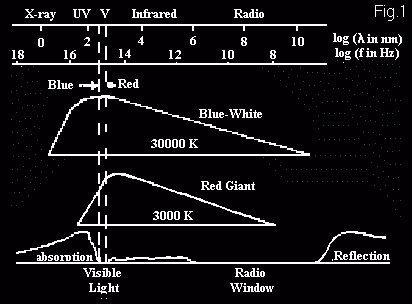
| If the complete spectrum of a body at a temperature of 30,000K is measured and plotted, a curve is produced as in Fig.1 which stretches all the way from X-rays to radio waves. It reaches a peak at a frequency of 5x1015 Hz, drops sharply at higher frequencies and much more gently at lower ones. |  |
| We do not need such detail. We can have a measure of the general shape of the spectrum of a star by sampling it using 'broad band' filters. The spectrum from the UV to the IR can be divided into five under a system known as Kron-Cousins, and ideally each filter would have a similar transmission characteristic as shown in Fig 2. | 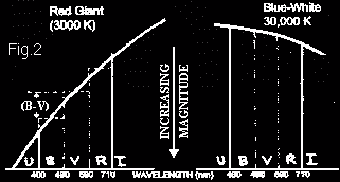 |
For each star, the difference between the adjacent bands (B-V), (V-R) etc.,
will provide a measure of the slope of the curve over that part of the
spectrum, and hence an indication of the colour balance and temperature.
These are called the Colour Indices. (B-V), the most commonly quoted
parameter, ranges in main sequence stars from -0.4 for a blue-white star to
>1.5 for a red giant. (As magnitudes increase as the star is fainter, these
values go in the opposite direction to first expectations!)
The 'colour temperature' derived in this way is that which a 'black body'
(or perfect radiator) would have with this colour index. However, it should
be remembered that the constituent elements and physical processes in the
star will distort the pattern of radiation, so it will be somewhat different
from the effective temperature. However, 'colour temperature' is still a
useful concept.
| The frames will show the variable (V) and comparison stars (1,2,3 etc) some of which will be brighter in the blue and UV, and others brighter in the red and IR. After pre-processing, suitable software can measure the brightness of the variable and each comparison star on each frame (U, B, V, R and I), and express it as a magnitude. | 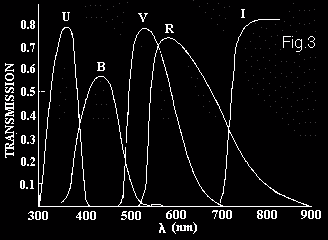 |
| Actual filters are made of coloured glass and have a response as in Fig.3 - peaking at some central frequency and dying away on each side, overlapping into the area of the adjacent filter. To complicate matters further, the CCD also varies in its response as in Fig.4, with substantial differences between different types of CCD. | 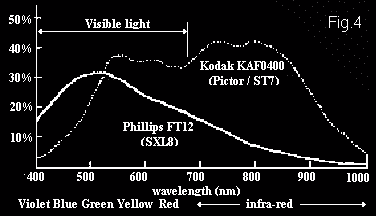 |
|
There are two types of coefficient:-
a. For each individual filter - a factor is required which relates the way the sensitivity of the system varies with the colour index of the star, ie. if, as in Fig.5, two stars have the same total output between green and yellow, but differently distributed, how does the instrumental magnitude vary? For each frame, the difference between the standard and instrumental magnitudes of each of the eight stars is plotted against their respective colour index as in Fig.6, and the best fitting slope determined. These Transformation Coefficients are known as tu, tb, tv, tr and ti. The slope should be around '0', ie. the the instrumental magnitude relative to its standard value should not change much, if at all, with colour index.
b. For each pair of adjacent filters - a factor is required which relates the
way the relative sensitivity varies with colour index of the star. |
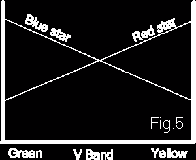
|
|
Fig.8 shows this for a flat earth which is acceptable for us as long as the
altitude of the star is >30°. The depth of the atmosphere through
which the light must pass is called the Air Mass and, relative to the
distance when it is overhead, is equal to Sec Z, the zenith angle, or Cosec
Alt. If a close pair of stars, one red and one blue, is observed rising from near the horizon to the meridian, their magnitudes determined and corrected with the transfer coefficients, and then plotted against their respective air mass as in Fig.9, two lines will be produced, one for the red star and one for the blue. These can be extrapolated to the vertical axis to derive the magnitudes that would have been measured if it had been done above the atmosphere. The extinction coefficients can be derived from this. |
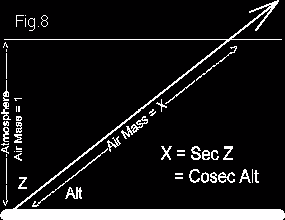
|